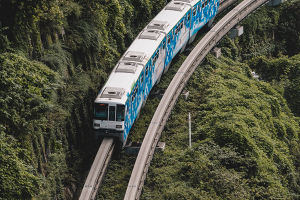Transit-Oriented Development (TOD) is a model proposed by Peter Calthorpe, a prominent figure in New Urbanism, a movement focusing on sustainable urban planning.
In response to the unchecked urban sprawl, TOD emphasizes the central role of public transportation in urban development.
It advocates for a departure from the traditional automobile-centric approach by promoting principles such as road grids, mixed-use zoning, appropriate development densities, pedestrian-friendly neighborhoods, and accessible facilities.
The core principles of TOD revolve around creating walkable communities, prioritizing high-quality public transportation, fostering mixed-use neighborhoods, aligning urban densities with public transportation capacity, facilitating quick commutes through compact urban areas, and regulating parking and road usage to enhance mobility.
In a TOD setting, residents can conveniently walk within 400 to 800 meters (5 to 10 minutes) of public transportation stations to access commerce, culture, education, and housing.
Today, TOD has become a widely adopted model for urban community development globally. While initially associated with highway construction and automobile commuting in the United States, the contemporary perception of leading urban development through rail transit is exemplified by Hong Kong and Japanese-style TOD.
Hong Kong's TOD model is based on the scarcity of developable land. The process involves the government selling land earmarked for development to the Mass Transit Railway (MTR) at pre-development prices. Subsequently, the MTR constructs railway lines, strategically placing stations on the designated land to attract real estate developers.
After the completion of the MTR lines, the appreciated land is sold to developers who proceed to build residential, commercial, and corporate structures. This coordinated effort achieves development objectives, benefiting stakeholders such as the government, MTR, developers, and residents.
In Japan, the development of railways in the late 19th century focused on connecting urban centers with rural areas, facilitating labor mobility and pilgrimages, and establishing trunk lines for freight and passenger transport.
Tokyo's Shibuya Station exemplifies Japanese TOD, characterized by an extensive network of intersecting subway lines and urban regeneration projects like Shibuya Mirai no Hikari. This mixed-use complex integrates commercial, office, and public facilities, contributing to Shibuya's vibrant culture and economic vitality.
In the United States, the New World Trade Center TOD stands as a quintessential example of the TOD model. This mixed-use complex features shopping centers, transit hubs, and pedestrian walkways, serving as a focal point for commuter traffic with connections to 11 subway lines.
Drawing 1.7 million visitors daily, it has evolved into a bustling financial hub, embodying the aspirational ideals of urban development worldwide.
In addition to the prominent examples of TOD in Hong Kong, Japan, and the United States, other regions worldwide are also embracing this model to address urbanization challenges.
European cities like Amsterdam and Stockholm have implemented TOD strategies to enhance public transportation access and reduce reliance on cars.
Similarly, cities in developing countries such as Brazil and India are exploring TOD as a means to mitigate congestion and pollution while promoting inclusive urban growth.
As urban populations continue to rise globally, the principles of Transit-Oriented Development offer a sustainable framework for creating vibrant, resilient, and livable communities across diverse cultural and geographical contexts.


